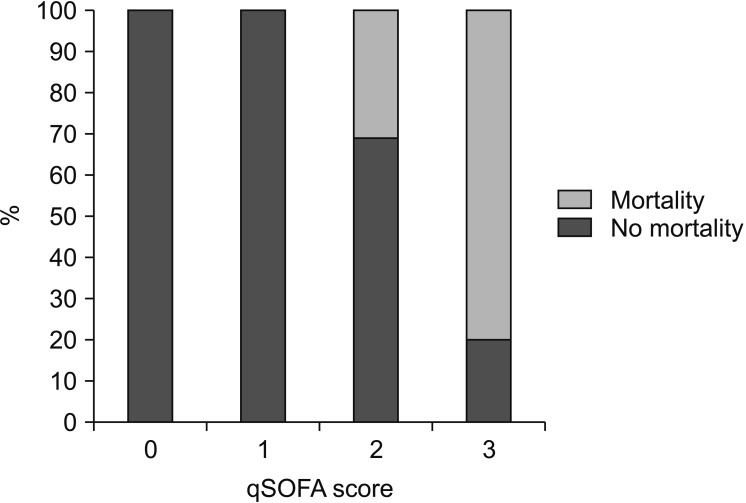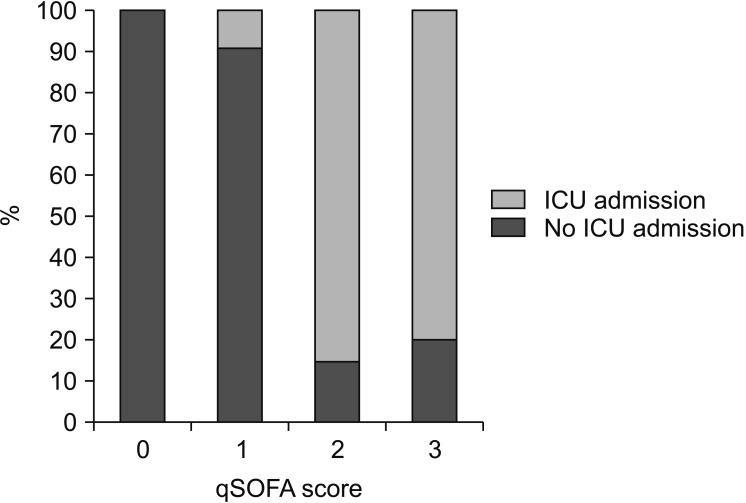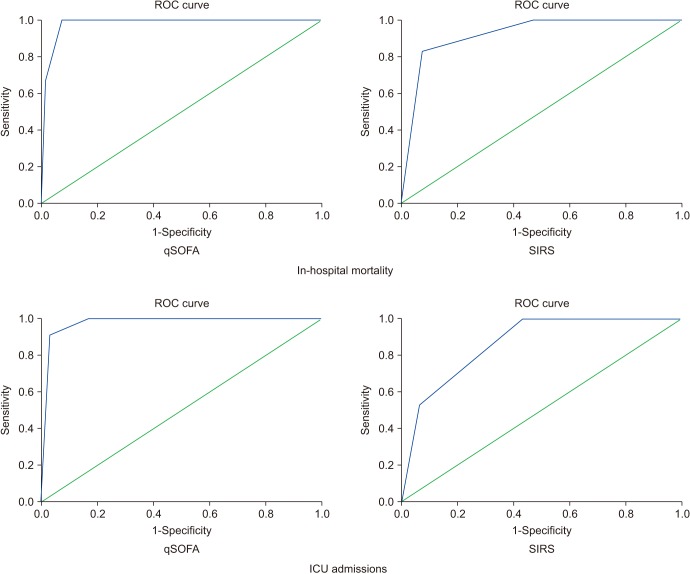Investig Clin Urol.
2019 Mar;60(2):120-126. 10.4111/icu.2019.60.2.120.
Quick Sequential (Sepsis related) Organ Failure Assessment: A high performance rapid prognostication tool in patients having acute pyelonephritis with upper urinary tract calculi
- Affiliations
-
- 1Department of Urology, King George's Medical University, Lucknow, India. sankhwarsn.sn@gmail.com
- 2Department of Pathology, Post Graduate Institute of Medical Education and Research, Chandigarh, India.
- KMID: 2438823
- DOI: http://doi.org/10.4111/icu.2019.60.2.120
Abstract
- PURPOSE
To analyze the utility of quick Sequential Organ Failure Assessment (qSOFA) in patients with uro-sepsis due to acute pyelonephritis (APN) with upper urinary tract calculi, we conducted this study. The role of qSOFA as a tool for rapid prognostication in patients with sepsis is emerging. But there has been a great debate on its utility. Literature regarding utility of qSOFA in uro-sepsis is scarce.
MATERIALS AND METHODS
Ours was a retrospective study including 162 consecutive patients who were admitted for APN with upper urinary tract calculi over a 3 and half years (total 42 months) period. We evaluated the accuracy of qSOFA in predicting inhospital mortality and intensive care unit (ICU) admissions and compared this with the predictive accuracy of systemic inflammatory response syndrome (SIRS). We used the Area Under Curve (AUC) of the Receiver Operator Characteristic curve to calculate it and also calculated the optimum cut off for qSOFA score.
RESULTS
The overall mortality and ICU admission rates were 7.4% and 12.9%, respectively. qSOFA had a higher predictive accuracy for in-hospital mortality (AUC, 0.981; 95% confidence interval [CI], 0.962-1.000) and ICU admissions (AUC, 0.977; 95% CI, 0.955-0.999) than SIRS. A qSOFA score of ≥2 was an optimum cut off for predicting prognosis. In a multivariate model qSOFA ≥2 was a highly significant predictor of in-hospital mortality and ICU admissions (p < 0.001).
CONCLUSIONS
qSOFA is a reliable and rapid bedside tool in patients with sepsis with accuracy more than SIRS in predicting inhospital mortality and ICU admissions.
MeSH Terms
Figure
Reference
-
1. Bone RC, Balk RA, Cerra FB, Dellinger RP, Fein AM, Knaus WA, et al. Definitions for sepsis and organ failure and guidelines for the use of innovative therapies in sepsis. The ACCP/SCCM Consensus Conference Committee. American College of Chest Physicians/Society of Critical Care Medicine. Chest. 1992; 101:1644–1655. PMID: 1303622.2. Levy MM, Fink MP, Marshall JC, Abraham E, Angus D, Cook D, et al. 2001 SCCM/ESICM/ACCP/ATS/SIS International Sepsis Definitions Conference. Crit Care Med. 2003; 31:1250–1256. PMID: 12682500.
Article3. Singer M, Deutschman CS, Seymour CW, Shankar-Hari M, Annane D, Bauer M, et al. The Third International Consensus Definitions for Sepsis and Septic Shock (Sepsis-3). JAMA. 2016; 315:801–810. PMID: 26903338.
Article4. Naber KG. Urogenital infections: the pivotal role of the urologist. Eur Urol. 2006; 50:657–659. PMID: 16647804.
Article5. Brun-Buisson C. The epidemiology of the systemic inflammatory response. Intensive Care Med. 2000; 26(Suppl 1):S64–S74. PMID: 10786961.
Article6. Fukushima H, Kobayashi M, Kawano K, Morimoto S. Performance of quick sequential (sepsis related) and sequential (sepsis related) organ failure assessment to predict mortality in patients with acute pyelonephritis associated with upper urinary tract calculi. J Urol. 2018; 199:1526–1533. PMID: 29291417.
Article7. Yoshimura K, Utsunomiya N, Ichioka K, Ueda N, Matsui Y, Terai A. Emergency drainage for urosepsis associated with upper urinary tract calculi. J Urol. 2005; 173:458–462. PMID: 15643207.
Article8. Pearle MS, Pierce HL, Miller GL, Summa JA, Mutz JM, Petty BA, et al. Optimal method of urgent decompression of the collecting system for obstruction and infection due to ureteral calculi. J Urol. 1998; 160:1260–1264. PMID: 9751331.
Article9. Hamasuna R, Takahashi S, Nagae H, Kubo T, Yamamoto S, Arakawa S, et al. Obstructive pyelonephritis as a result of urolithiasis in Japan: diagnosis, treatment and prognosis. Int J Urol. 2015; 22:294–300. PMID: 25400222.
Article10. Yamamoto Y, Fujita K, Nakazawa S, Hayashi T, Tanigawa G, Imamura R, et al. Clinical characteristics and risk factors for septic shock in patients receiving emergency drainage for acute pyelonephritis with upper urinary tract calculi. BMC Urol. 2012; 12:4. PMID: 22413829.
Article11. Freund Y, Lemachatti N, Krastinova E, Van Laer M, Claessens YE, Avondo A, et al. Prognostic accuracy of Sepsis-3 criteria for in-hospital mortality among patients with suspected infection presenting to the emergency department. JAMA. 2017; 317:301–308. PMID: 28114554.
Article12. Raith EP, Udy AA, Bailey M, McGloughlin S, MacIsaac C, Bellomo R, et al. Prognostic accuracy of the SOFA score, SIRS criteria, and qSOFA score for in-hospital mortality among adults with suspected infection admitted to the intensive care unit. JAMA. 2017; 317:290–300. PMID: 28114553.
Article13. Sartelli M, Kluger Y, Ansaloni L, Hardcastle TC, Rello J, Watkins RR, et al. Raising concerns about the Sepsis-3 definitions. World J Emerg Surg. 2018; 13:6. PMID: 29416555.14. Tusgul S, Carron PN, Yersin B, Calandra T, Dami F. Low sensitivity of qSOFA, SIRS criteria and sepsis definition to identify infected patients at risk of complication in the prehospital setting and at the emergency department triage. Scand J Trauma Resusc Emerg Med. 2017; 25:108. PMID: 29100549.
Article15. Askim Å, Moser F, Gustad LT, Stene H, Gundersen M, Åsvold BO, et al. Poor performance of quick-SOFA (qSOFA) score in predicting severe sepsis and mortality-a prospective study of patients admitted with infection to the emergency department. Scand J Trauma Resusc Emerg Med. 2017; 25:56. PMID: 28599661.
Article16. Henning DJ, Puskarich MA, Self WH, Howell MD, Donnino MW, Yealy DM, et al. An emergency department validation of the SEP-3 sepsis and septic shock definitions and comparison with 1992 consensus definitions. Ann Emerg Med. 2017; 70:544–552.e5. PMID: 28262318.
Article17. Giamarellos-Bourboulis EJ, Tsaganos T, Tsangaris I, Lada M, Routsi C, Sinapidis D, et al. Validation of the new Sepsis-3 definitions: proposal for improvement in early risk identification. Clin Microbiol Infect. 2017; 23:104–109. PMID: 27856268.18. Sartelli M, Catena F, Ansaloni L, Coccolini F, Corbella D, Moore EE, et al. Complicated intra-abdominal infections worldwide: the definitive data of the CIAOW Study. World J Emerg Surg. 2014; 9:37. PMID: 24883079.
- Full Text Links
- Actions
-
Cited
- CITED
-
- Close
- Share
- Similar articles
-
- Risk Factors of Sepsis in Obstructive Acute Pyelonephritis Associated with Urinary Tract Calculi
- Modified quick-SOFA score: Can it enhance prognostic assessment for hospitalized patients with chronic liver diseases?: Editorial on “Dynamic analysis of acute deterioration in chronic liver disease patients using modified quick sequential organ failure assessment”
- Risk Factors of Sepsis and Factors Influencing the Decision to Perform Emergency Drainage in Obstructive Acute Pyelonephritis Secondary to Urinary Calculi
- Clinical Use of Procalcitonin in the Diagnosis of Sepsis: Evaluation of PCT–qSOFA
- Two Cases of Xanthogranulomatous Pyelonephritis




